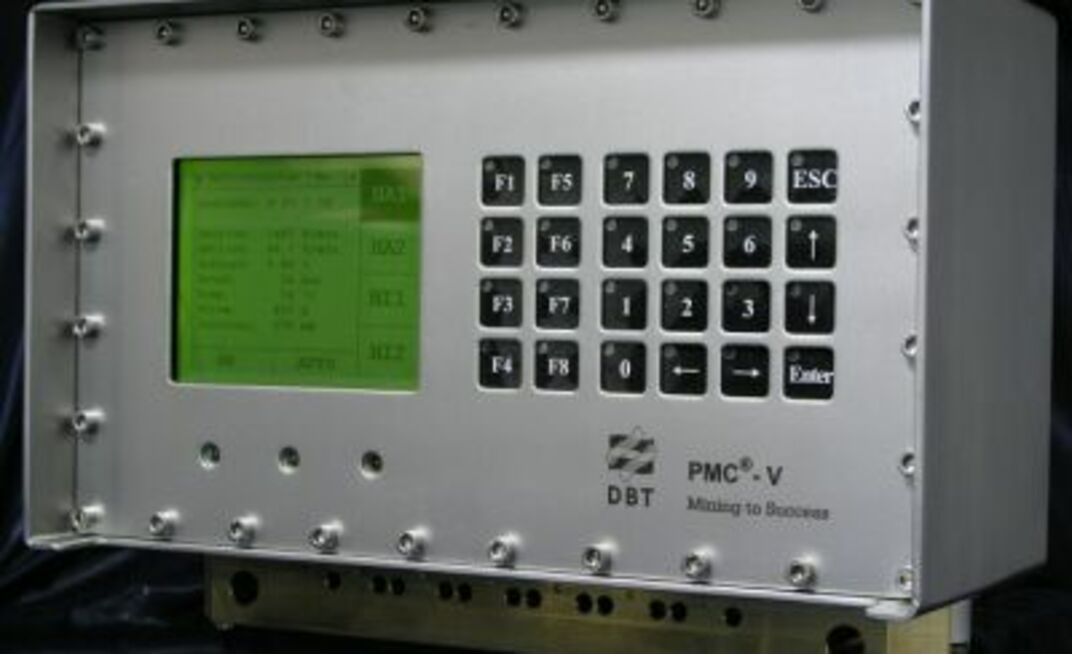The PMC®-D is a modern control system for the intelligent drive systems. It incorporates the PMC-V for visualization and PMC-G, a gateway for networking of multiple drive controls. Communicating via fieldbus, the new PMC® controls feature higher computing capacity bringing a further improvement in control quality and enhanced diagnostics for CST (Controlled Start Transmission) drives.
The PMC® family comprises of a number of different control units: PMC®-D (Drive), PMC-V (Visualization), PMC-G (Gateway) and the PMC-R Roof Support Control system as well as various transducers and actuators. The components of the PMC®-D system were developed within the PMC® family architecture.
The hardware is based on long-term experience gained with the PM 4 system for shield control applications. Like the PM 4, PMC® units are designed and built for the harsh underground mining environment, meeting the demands of different countries, such as environmental requirements of different coal companies as well as the standards for intrinsically safe systems and explosion-proof systems. According to DBT this has resulted in long service life, high reliability, high availability and low failure rates.
The drive control software is based primarily on many years of operational experience by DBT with the intelligent CST (Controlled Start Transmission) drive system for face conveyors.
The network for CST applications is based on the communication between the PMC®-D, PMC-V and PMC-G units. Communication is fieldbus based. Connections are established using 4-core twisted-pair cables. When mounted in the vicinity of the gearbox, they are protected by a pressure hose as standard. The SKK 24 connector used has proved very reliable and robust with more than 18,000 installed in PM 4 units worldwide.
DBT said this type of network allowed for easy maintenance, including simple detection and location of cable breaks. The communication rate is 93,75 KBaud ensuring fast data transmission for accurate system control. The standard setup uses one PMC®-D mounted at each gearbox plus one or more PMC-V units for visualization and parameter setting, trending, etc.
The PMC-G gateway is used for external communication (that is, to the surface or a mine-wide communication system) and for the reading of variables such as motor current.
An underground PC, (such as the DBT ExPC) running the special DBT V-CST visualization software can be used for visualization at the face end. This also allows data storage as well as recording & playback of operational functions.
The PMC®-D control unit itself is based on a 16-/32-bit CPU, programmed in C. It is facilitating maintenance and software development. One control unit is dedicated to each gearbox. The unit contains all necessary hardware as well as the time-tested CST control algorithms previously included in two separate units.
Connected to a distribution box within the CST gearbox, PMC®-D control unit collects all gearbox data (such as clutch pressure, oil temperature, input and output speed), calculates the necessary slip, and controls the pressure for the CST clutch via a high-speed proportional valve.
Equipped with an easy-to-read ¼ VGA display, the PMC®-D offers access to all gearbox data. Programming changes are implemented by rebooting the entire system, while parameter setting can be undertaken from any attached PMC-V. High flexibility for varying numbers of sensors and actuators allows adaptation to different applications.
Software is available for various modes of operation of CST systems, especially for sequential no-load motor start-up, synchronized AFC soft-start and heavy-load start-up, accurate load sharing, fast overload protection, slow running (such as for chain inspection), and data storage.
Packaged in a stainless steel housing similar to the proven PM 4, the PMC®-D is a rugged high-reliability, high availability system for the harsh underground environment. The use of established technology, robust, reliable sensors, programming in C, and fieldbus technology ensure minimization of maintenance effort. The EMC-compatible control unit and peripheral components rated at IP 68, for 48-hour 1 m submersion in water as the result of O-ring protection for keyboard, stop switches and cable connectors.
Combined with an underground or surface visualization system allows a database for all shield data, data logging for more than four weeks, and a record function that allows playback of shifts or days.
The PMC-V Visualization Control Unit has a 24-key keyboard for easy operation and a 1/4 VGA display for data visualization and display of trends, graphics and any error messages. Like the operating unit the PMC-V can display messages in different languages including as English, German, Russian and Chinese.
The PMC-V menu shows all data available from the gearboxes. This includes all transducer values, status information, all global and local parameters, and network status. Although it is easy to change parameters, typically the system is password-protected. It is not normally necessary to change parameters from a main control unit.
The PMC-G is a gateway computer serving three main purposes - communication with other mine computers, reading the motor current for slip control, and interfacing with the PC running the V-CST visualization software.
The PMC®-D system allows the use of various transducers. Typical transducers for the intelligent CST drive system include pressure sensors (for measuring pressure of 0 – 100 bar (0 – 1450 psi) for clutch pressure), a pressure transducer for cooling oil pressure, a pressure switch for detection high-pressure filter status, a stroke sensor for oil level and proximity switches for input and output speed.
The main actuator for the intelligent CST drive system is the high-speed proportional valve for CST clutch pressure adjustment.
In addition to controlling CST, PMC®-D system components can be used individually or in combination to control other systems, including DBT’s fully automated chain tensioning system for chain conveyors, any drive system for underground systems with sensors and actuators, room & pillar equipment, and belt conveyor systems.
























